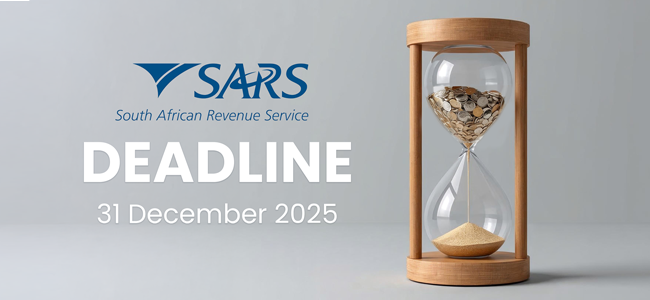Key Tax Updates for 2025/26 in South Africa
The South African Revenue Service (SARS) has released its 2025/26 Budget Tax Guide, offering individuals and businesses critical updates to help them remain compliant and efficient in their financial planning. Tax remains one of the most significant factors impacting take-home pay, investment planning, and business operations.
From 1 March 2025 to 28 February 2026, the tax brackets for individuals and special trusts have remained unchanged. The starting rate remains at 18% for income up to R237 100, scaling to 45% for income exceeding R1 817 000. Notably, there have been no inflationary adjustments to personal income tax brackets or rebates. The primary rebate stands at R17 235, with additional rebates for individuals over 65 and 75

Retirement and Savings-Related Tax Rules
Retirement fund withdrawals and benefits have their own unique tax tables. Withdrawals up to R27 500 are tax-free, with rates increasing in bands up to 36% for larger lump sums. New tax treatment for savings withdrawals under the two-pot retirement system now applies, with withdrawals from the savings component taxed at marginal rates.
Capital Gains, Dividends, and Interest
Capital gains tax (CGT) rates remain consistent, with a maximum effective rate of 18% for individuals. Dividends continue to be taxed at a flat 20% unless exempted under specific conditions. Foreign dividends are generally taxed at up to 20%, and interest exemptions remain at R23 800 for those under 65 and R34 500 for those over.

Fringe Benefits and Travel
Employers must take note of updated fringe benefit calculations for vehicles, accommodation, and interest-free loans. Vehicle travel deductions are based on a refined table, with costs calculated per kilometre depending on vehicle value. A rate of R4.76/km applies for simplified business travel reimbursements.
Business Taxation and Turnover
Companies will continue to be taxed at 27%. Small Business Corporations (SBCs) and Micro Businesses benefit from tiered tax structures that offer relief at lower income levels. Turnover tax remains 0% for income up to R335 000, gradually increasing to a maximum of 3%.
Levies and Withholding Taxes
The Skills Development Levy (SDL), Unemployment Insurance Fund (UIF) contributions, and withholding taxes on royalties, interest, and dividends continue as per previous years, with slight increases in excise duties on alcohol, tobacco, and fuel starting June 2025.




